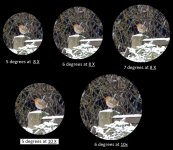The bottom line is simple: if the target of interest is far enough away a 10X bin will beat an equivalent 8X. Assuming, of course, you can hold the 10X bin steady.
This is absolutely correct of course but the logic doesn't come to a halt with 10x magnification. There are targets just too far away for a 10x but which a 12x would reveal, while targets even further away are only accessible by 15x. Of course you can carry a scope to address this but atmospheric conditions can reduce the effectiveness of higher magnifications.
Meanwhile at close ranges, in the 30 years I only used 10x, I sometimes missed targets due to the 10x modest depth of field when I couldn't refocus fast enough. I decided I was missing more nearby targets than I was gaining far distant targets and moved to 8x and after I got control of my 'reduced magnification anxiety' I discovered that for me 8x is a better all-rounder.
As always its a balance and I do enjoy a 10x in specific places.
Lee







